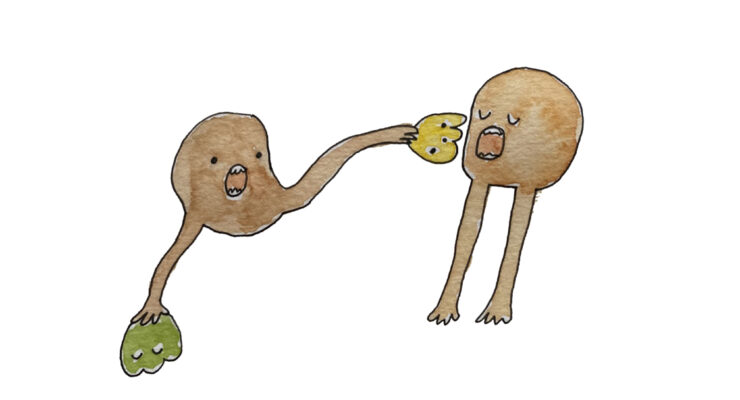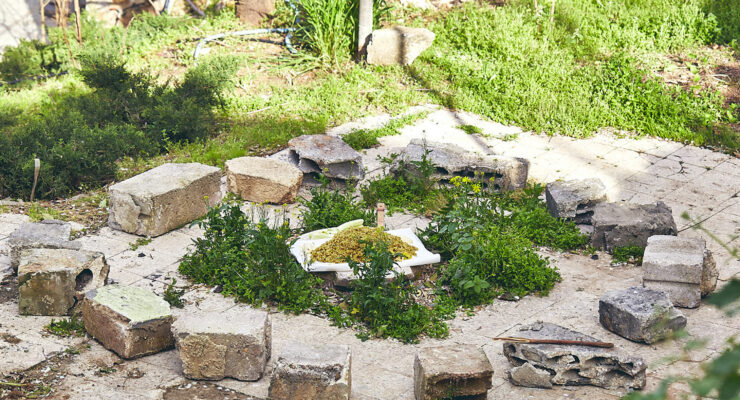Food and Planetary Geologies Part 2
Our Berlin-based Food, Design & Innovation correspondent, Alexandra Genis, looked to space and earth for us. In this second part of her essay for us, about questioning and rethinking food as an intermediary between living and dead matter, she looks to space.
June 2020 – Berlin
Earth seems much more edible than I would have expected. Food particles were found in meteorites hailing from space. Ancient sugar molecules might have transported life to Earth millions of years ago. Meanwhile, in the Anthropocene, our food-waste is accumulating to form the mountains and valleys of the future. This mysterious involvement of food in the spheres of geology and terraforming interested me. I interviewed a Japanese researcher working with NASA, who has found sugar in a meteorite, and a Swedish Speculative Design-duo, investigating chicken-bone sediments. Could thinking differently about food, namely as the physical mediator between living organisms and ‘dead matter’ give us a better understanding of our connectedness to this planet and the planets beyond?
Part Two – Space Candy
“NASA has found sugar in meteorites that crashed to Earth” is the title of an article by CNN I read in late 2019, which engaged my fantasy. What would it mean for humans today that sugar has been floating freely through space? I emailed NASA and asked for an interview. The team referred me to Japan, to contact Yoshihiro Furukawa, the main author of the study. Yoshi, as he introduces himself, is a prebiotic scientist at the Department of Earth Science, Tohoku University in Sendai, Japan.
"Not every asteroid in space carries sugars"
This means he studies how organisms evolved on Earth before life came about. A part of his research includes the collection of meteorites found on different continents which he receives from other institutes. (Note: An asteroid is a piece of stone in space, while a meteorite is a piece of stone which fell on Earth from space.) He then scans them for particles that might carry the seed of life. He tells me that sugar and proteins have been found in meteorites before in the early 2000s, so he is not as excited about his latest find as CNN. “Not every asteroid in space carries sugars”, Yoshihiro says.
"Meteorite" by Yoshihiro Furukawa

"Ribose" by Yoshihiro Furukawa

“Approximately 97% of all meteorites are free of any ingredients for life.” But sometimes he gets lucky. The researcher is especially interested in ribose, which is a sugar. Differently from glucose or fructose, ribose has a special place in the study of prebiotics. “Ribose is an essential part of RNA (Ribonucleic Acid) and we know today that RNA preceded DNA in the formation of life.” To my question whether he licked the meteorite to check if it’s sweet he laughs and tells me the quantity of ribose contained in the stone is so minuscule, he would not be able to taste anything – which, I think, is a pity. I wonder if the meteorites lie around in the fields before being picked up, how do we know that the sugar is not from Earth? It turns out that in fact, the structure of the ribose from outer space is different from sugar particles found here.
What the researchers get from studying those meteorites is more and more evidence that life on Earth might have been brought by a set of meteorites hailing from the asteroid belt between Mars and Jupiter. “We know for sure that the same ribose-containing objects fell on Mars,” the scientist shares with me before we end the call.
Yoshihiro’s favorite food is Dashi, a traditional Japanese fish stock for making soups such as Miso. He says Dashi is full of sugar. You can find more information about the findings of Yoshihiro in this NASA article.
_

Article by our Food, Design & Innovation correspondent Alexandra Genis.










